Abstract
In this paper, a time dependent singularly perturbed differential-difference convection-diffusion equation is solved numerically by using an adaptive grid method. Similar boundary value problems arise in computational neuroscience in determination of the behaviour of a neuron to random synaptic inputs. The mesh is constructed adaptively by using the concept of entorpy function. In the proposed scheme, prior information of the width and position of the layers are not required. The method is independent of perturbation parameter ε and gives us an oscillation free solution, without any user introduced parameters. Numerical examples are presented to show the accuracy and efficiency of the proposed scheme.
1 Introduction
Singularly perturbed partial differential equations arise in a wide variety of application fields such as biosciences, economics, material science, medicine, robotics etc. [5, 14, 20] and in the last few decades there has been a growing interest in the study of delay differential equations [3, 4, 9]. In 1965 Stein [19] proposed a mathematical model of neuronal variability to study the stochastic movement of neuron. Later he generalized the model to study the distribution of past synaptic potential amplitudes. In 1991 Musila and Lansky [13] generalised the Stein’s model and given the following mathematical model:
Here, due to exponential decay between two consecutive jumps caused by the input processes, the first derivative term will occur. The membrane potential decays exponentially to the resting level with a membrane time constant τ and μD and σ are diffusion moments of Wiener process characterizing the influence of the dentritic synapses on the cell excitability. The reaction terms correspond to the superposition of excitatory and inhibitory inputs and we can assume that they are Poissonian. The excitatory input contributes to the membrane potential by amplitude as with intensity λs and similarly the inhibitory input contributes by amplitude is with intensity ωs. This model makes available time evolution of the trajectories of the membrane potential.
Lange and Miura [11], studied the asymptotic analysis of singularly perturbed boundary value problems for differential-difference equations in ordinary differential equations. This study motivated many researchers to work on numerics of singularly perturbed differential-difference equations in ordinary differential equations and partial differential equations. Here we are concerned with the partial differential equations of convection-diffusion type with general shift arguments, which are singularly perturbed. It is noticeable that the behavior of the solution of singularly perturbed partial differential equations with shift arguments are essentially different from those of without shift arguments.
Ramesh and Kadalbajoo [15] proposed a numerical scheme based on classical finite differences on the Shishkin mesh for solving singularly perturbed partial differential-difference equations with small shift arguments. The method is found to be uniformly convergent with respect to the perturbation parameter. Kumar and Kadalbajoo [9] had given a B-spline collocation method on fitted mesh for solving singularly perturbed partial differential-difference equations with small shift arguments. In [9, 15], they approximated the shifted terms by Taylor series and difference schemes are applied. Such methods will work when shifts are smaller than perturbation parameter and fails in the case when shifts are bigger than perturbation parameter. Bansal et. al.[3, 4] developed parameter uniform numerical schemes to find the approximate solution of time dependent singularly perturbed convection-diffusion-reaction problems with general shift arguments in space variable, which work for small shifts as well as large shifts. Rao and Chakravarthy [16] had given a fitted numerical scheme for singularly perturbed one-dimensional parabolic partial differential equations with small shifts.
If we solve singularly perturbed partial differential equations using central finite difference scheme on a uniform mesh, it gives oscillatory solution, which shows that method is unstable. To deal with such situation, more mesh points in boundary layer region is required. To cater the need, layer adaptive meshes have been developed by Bakhvalov [2], Gartland [8] and others. A special piecewise uniform meshes have been proposed by Miller and Shishkin [12]. Shishkin meshes are used widely because of their simplicity. The major drawback of Shishkin meshes is the requirement of prior information of the location of the layer regions. To overcome this drawback, in this paper, we proposed an adaptive mesh method using the concept of entropy function for solving convection-diffusion-reaction singularly perturbed delay parabolic partial differential equations. The method is independent of perturbation parameter ε and gives us an oscillation free solution, without any user introduced parameters.
The paper is organized as follows: The problem under consideration is stated and the sufficient compatibility conditions on the initial and boundary data to guarantee the existence, uniqueness and appropriate regularity of the solutions to the problem are presented in Section 2. Numerical scheme and variable mesh algorithm is presented in Section 3. Section 4 is devoted to the stability and error analysis. To demonstrate the efficiency and applicability of the proposed numerical scheme, numerical experiments are carried out for three test problems and results are given in Section 5. The paper ends with conclusions in last section.
2 Statement of the problem
Let Ω = (0, 1), D = Ω × (0, T], for some fixed time T and Γ = Γl ∪ Γb ∪ Γr, where Γl = {(x, t) : − δ ≤ x ≤ 0, and 0 ≤ t ≤ T} and Γr = {(x, t) : 1 ≤ x ≤ 1 + η, and 0 ≤ t ≤ T} are the left and the right sides of the domain D and Γb = [0, 1].
In this paper, we consider a class of time dependent singularly perturbed partial differential difference equation with initial condition and the interval boundary conditions of the from:
where (x, t) ∈ D,
where 0 < ε ≪ 1 is the singular perturbation parameter, δ, η > 0 represent the shift parameters. The functions a(x), b(x), c(x), d(x), f(x, t), ϕb(x), ϕl(x, t), ϕr(x, t) are assumed to be smooth and bounded functions on D, that satisfy the conditions b(x) + c(x) + d(x) ≥ α > 0 on Γb = [0, 1], for some constant α. When δ = η = 0, the above problem reduces to singularly perturbed partial differential equation. If a(x) ≥ β > 0, for some constant β, c(x) < 0 and d(x) < 0 for all x ∈ Γb = [0, 1], then the solution exhibits boundary layer along x = 1.
The problem (1) with initial condition and the interval boundary conditions (2), can be rewritten as
where
and
The existence and uniqueness of a solution of (1) can be established under the assumption that the data are Holder continuous and also satisfy appropriate compatibility conditions at the corner points (0, 0), (1, 0), (−δ, 0), (1 + η, 0) then the required compatibility conditions are [18]
and
These conditions guarantee that there exists a constant C independent of ε such that ∀ (x, t) ∈ D,
Lemma 2.1
(Maximum principle) Let the functionφ(x, t) ∈ C2,1(D), such that 𝓛εφ(x, t) ≥ 0 inDandφ(x, t) ≥ 0 for all (x, t) ∈ (D − D). Thenφ(x, t) ≥ 0 for all (x, t) ∈ (D).
Proof
Let there exists (xp, tq) ∈ D, for some positive integer p and q such that
and also assume that φ(xp, tq) < 0. From our assumption it is clear that (xp, tq) ∉ (D − D), which implies that (xp, tq) ∈ D. Since at the point (xp, tq) function φ attains minimum, so φt = φx = 0, φxx ≥ 0 at point (xp, tq) and b(x) + c(x) + d(x) > 0, c(x) < 0 and d(x) < 0 for all x ∈ [0, 1]. Using differential operator 𝓛ε on φ(x, t), from (3) we have for 0 < xp ≤ δ and 0 < tq ≤ T,
for δ < xp < 1 − η and 0 < tq ≤ T
for 1 − η ≤ xp ≤ 1 and 0 < tq ≤ T
which contradict our assumption as 𝓛εφ(x, t) ≥ 0 in D. So we have φ(x, t) ≥ 0 for all (x, t) ∈ (D). □
Lemma 2.2
Ifu(x, t) satisfies the maximum principle then forn = 0, 1 and 2, the derivatives of the exact solutionu(x, t) of the model problem(1)satisfy the following bound
whereCis a generic positive constant independent ofε.
Proof
First we prove the bound for n = 0. We have,
since ϕb(x) ∈ C2(D) and t is bounded.
Now we have to prove the bound for n = 1,
we have u ≡ 0 along x = 0 and x = 1, therefore ux ≡ 0 and uxx ≡ 0. Now for t = 0,
using above conditions on u, we have
Apply the differential operator 𝓛ε on ut(x, t)
which implies that,
using maximum principle,
Similarly one can prove the result for n = 2. □
Theorem 2.3
Forn = 0, 1, 2, 3 and 4, the derivatives of the exact solutionu(x, t) of the model problem(1)satisfy the following bound
whereCis a generic positive constant independent ofε.
Proof
The proof of this theorem can be found in [3]. □
3 Numerical Scheme
In this section, we present a numerical scheme which works nicely when the delay and advance parameters are larger than perturbation parameter. To describe the method, we consider the linear singularly perturbed partial differential equation (1) subject to the initial and interval boundary conditions (2). Let the time interval [0, T] be partitioned into N equal parts with constant step size Δt. Let 0 = t0, t1, … tN = T be the mesh points. Then we have tj = j
Applying backward Euler formula for time derivative in equation (1) we obtain
where Uj = U(x, tj) ⋍ u(x, tj), for j = 1, 2, …, N.
After rearranging the terms in above equation, we get
This can be rewritten as
where
and
3.1 Finite difference operators for a non-uniform mesh
The first order forward, backward and central difference operators in space on non-uniform mesh(adaptive mesh) points xi are defined as
respectively and the second order central difference operator
Using above finite difference operators on a non-uniform mesh, we have
The initial and interval boundary conditions can be rewritten as
We solve (11) along with the conditions (12) using central difference scheme with minimum number of mesh points on uniform mesh in space direction. The presence of the singular perturbation parameter ε leads to occurrences of wild oscillation in the numerical solution. In order to avoid such oscillations, a large number of mesh points are required in layer region, when ε is very small. To overcome this, we generated a variable mesh using entropy function. The strategy for generating an adaptive mesh is given in the following subsection.
3.2 Mesh Selection Strategy
Now, we define, the entropy production equation by multiplying with an appropriate test function. From the theory of scalar conservation law, we know that U2 is always an appropriate entropy variable and therefore 2U(x, tj) is a suitable multiplying test function [10]. On multiplying with the test function, we obtain
After simplifying, equation (13) can be written as
where Z = U2.
The above equation can be rewritten as
The right-hand side of the equation (14) is considered as our entropy function and is always negative for all values x ∈ [0, 1]. As we know that, if we solve equation (11) by using central difference method, we get oscillations inside and near the boundary layer region. We calculate the discrete analogue of left hand side part in (14) using the same central difference operator by taking
we get the positive value whenever the oscillations occur, where Ui is the central difference computed solution. To generate the variable mesh, first we calculate entropy function with minimum number of initial uniform mesh points in space direction. To handle the delay and advance terms, we construct a special mesh, so that the terms containing the shifts lie on nodal point after discretization on uniform mesh. We find out the mesh point, where the entropy is maximum and positive. We add mesh points, one to the left and other to the right side of the mesh point where entropy is maximum and positive. Now, we compute the solution with newly generated mesh points (non uniform mesh) using central difference method and check whether the entropy is positive or negative through out the interval of integration. If the entropy is positive, we pick up the mesh point where the entropy is maximum and positive and we repeat the process of adding mesh points both sides. We repeat this process till we get entropy negative through out the interval of integration.
4 Stability and Error analysis
Use the difference operators for a non-uniform mesh in (11), since hi = xi+1 - xi, hi−1 = xi − xi−1 and hi + hi−1 = xi+1 − xi−1. For 1 < k, l < M, we have
and
On rearrangement, the Equation (16)-(17) can be written as
where
and
provided |ai| ≤ 2ε/hi−1 and |ai| ≤ 2ε/hi.
For i = 1, 2, …, k and j = 1, 2, …, N,
since bi > 0 and di < 0 on [0, 1] and Δt is step size in temporal direction. We have
For i = k + 1, k + 2, …, M − l − 1, and j = 1, 2, …, N,
since bi > 0, ci < 0 and di < 0 on [0, 1] and Δt is step size in temporal direction. We have
For i = M − l, M − l + 1, …, M, and j = 1, 2, …, N,
since bi > 0 and ci < 0 on [0, 1] and Δt is step size in temporal direction. We have
which shows that the given system is diagonally dominant. The scheme is stable and the unknown Ui.j must be solved at each time level.
Truncation error:
Let M∗ is number of mesh interval on an adaptive mesh obtained using entropy function concept. If xi is ith mesh point on M∗. We define left hand and right hand side distance by
Using Taylors series expansion
and
using these expansions in Eq. (18), we get
After simplification the terms, the truncation error is
which can further be simplified to
as hi−1, hi → 0 and Δt → 0 the T.E. → 0, which shows that scheme is consistent and the truncation error of the scheme is of order O(hi − hi−1, Δt). The Lax equivalence theorem says that a finite difference approximation for a properly posed partial differential equation satisfying consistency and stability are necessary and sufficient conditions for convergence.
5 Numerical results
To demonstrate the efficiency and applicability of the proposed numerical scheme, numerical experiments are carried out for three test problems of singularly perturbed partial differential equations with large shifts parameters. The exact solution of the problems are not known, so the maximum point wise errors are calculated using the following double mesh principle [6]:
where UM*,N(xi, tj), denote the numerical solution obtained on a mesh containing M* + 1 points in spatial direction and N + 1 points in temporal direction.
The numerical rate of convergence is calculated using the formula
We use the notation M, N for mesh intervals in space and time direction, on uniform mesh and M* for final adaptive mesh intervals in space direction.
Example 5.1
[3] Consider the following singularly perturbed partial differential equation:
where (x, t) ∈ (0, 1) × (0, 3] and is subject to the following interval boundary conditions and the initial condition,
The adaptive mesh generation with ε = 2−10, for this example is plotted in Figure 1. The numerical solution of the central finite difference scheme on uniform mesh and on adaptive mesh for three different time levels with ε = 2−14, δ = 0.2 and η = 0.4, for this example, is plotted in Figure 2a and Figure 2b. To examine the effect of shift parameters on the boundary layer behaviour of the solution, surface plot of the solution of example 5.1 for different values of ε and δ and η, using adaptive mesh is plotted in Figure 3a and Figure 3b. The maximum point wise errors and rate of convergence are presented in Table 1 for this boundary value problem for different values of perturbation parameter ε.
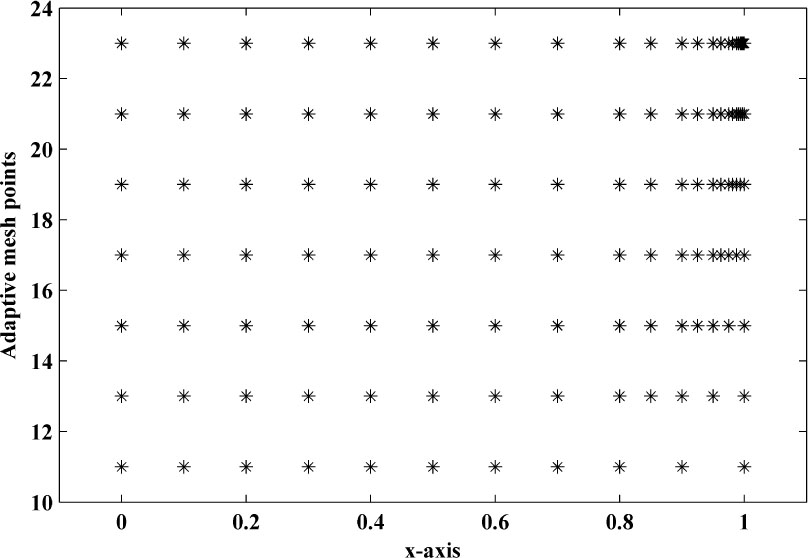
Adaptive mesh generation for example 5.1 with ε = 2−10, δ = 0.6, η = 0.7, M=10(initially) and N=20.
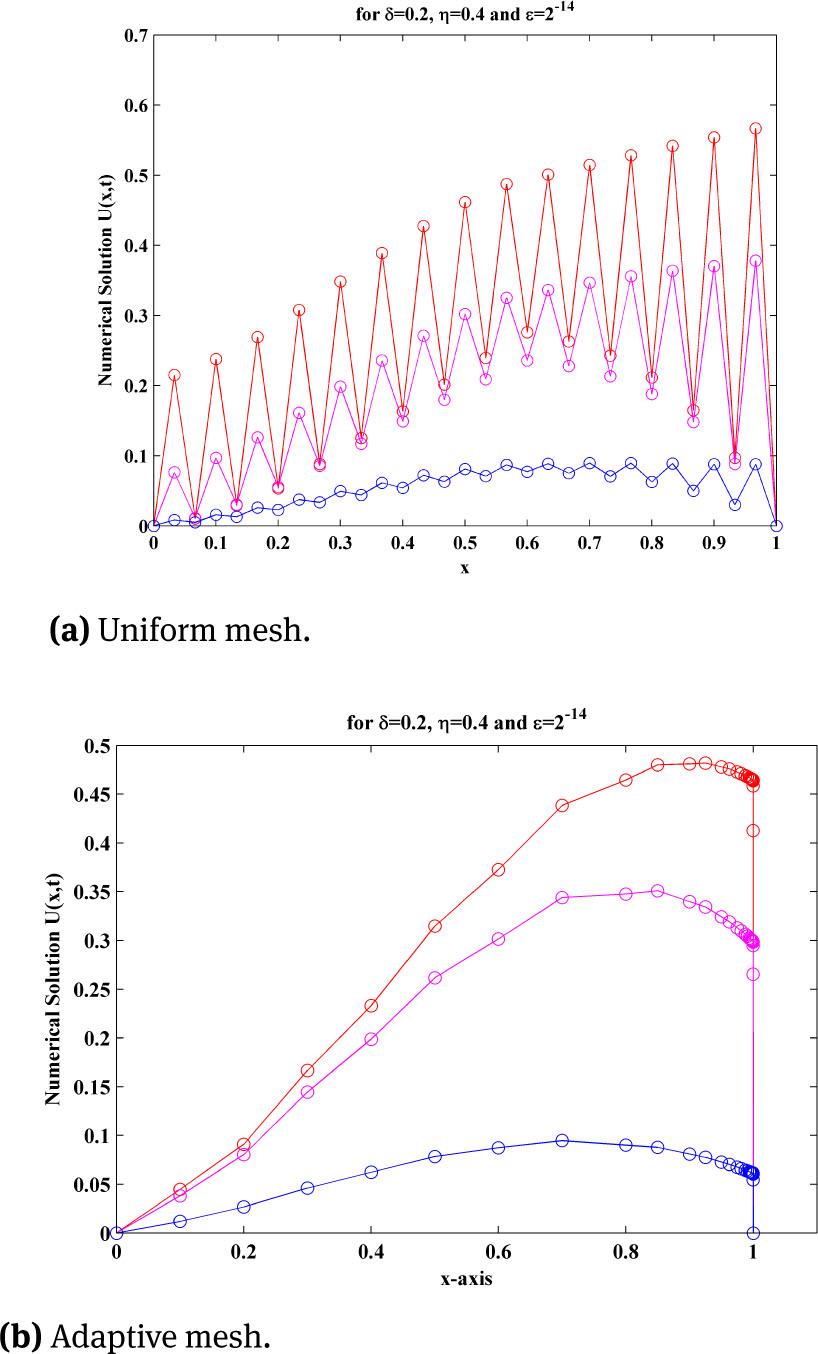
Numerical solution of example 5.1, using uniform mesh and adaptive mesh for three different time level with ε = 2−14, δ = 0.2, η = 0.4, M=30 and N=20.
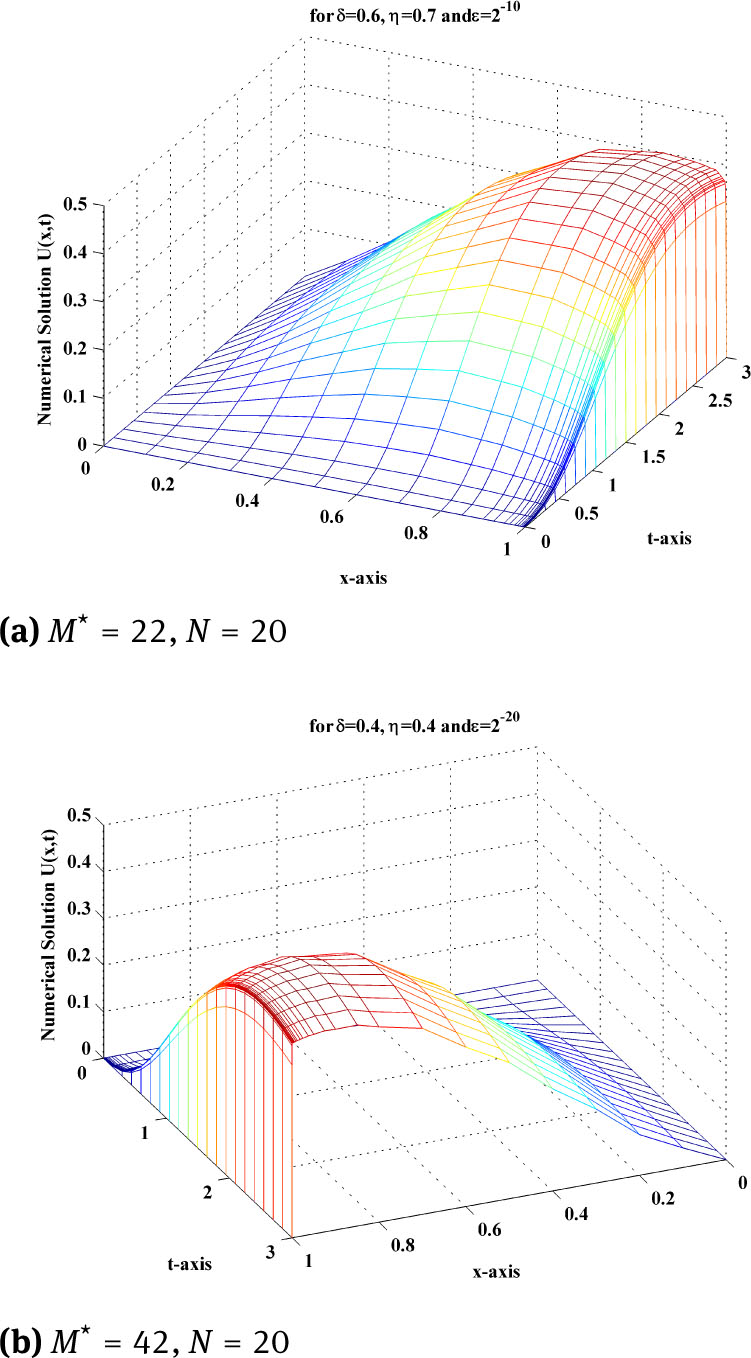
Surface plot of example 5.1, using adaptive mesh for different values of ϵ, δ and η.
Maximum point wise errors of the solution and corresponding rate of convergence for Example 5.1 by taking δ = 0.6, η = 0.7, M=10 and N=20 for different values of ε.
| ε | Generated mesh | Max. error | Rate of Convergence |
|---|---|---|---|
| (M*) | (RM*,N) | ||
| 2–10 | 22 | 2.3422e-02 | 2.2166 |
| 2–11 | 24 | 2.4004e-02 | 2.2086 |
| 2–12 | 26 | 2.4260e-02 | 2.2037 |
| 2–13 | 28 | 2.4377e-02 | 2.2012 |
| 2–14 | 30 | 2.4432e-02 | 2.1910 |
| 2–15 | 32 | 2.4460e-02 | 2.1993 |
| 2–16 | 34 | 2.4473e-02 | 2.1991 |
| 2–17 | 36 | 2.4479e-02 | 2.1989 |
| 2–18 | 38 | 2.4483e-02 | 2.1989 |
| 2–19 | 40 | 2.4484e-02 | 2.1988 |
| 2–20 | 42 | 2.4485e-02 | 2.1988 |
| 2–21 | 44 | 2.4485e-02 | 2.1988 |
| 2–22 | 46 | 2.4486e-02 | 2.1988 |
| 2–23 | 48 | 2.4486e-02 | 2.1988 |
| 2–24 | 50 | 2.4486e-02 | 2.1988 |
| 2–25 | 52 | 2.4486e-02 | 2.1988 |
| 2–26 | 54 | 2.4486e-02 | 2.1988 |
| 2–27 | 56 | 2.4486e-02 | 2.1988 |
| 2–28 | 58 | 2.4486e-02 | 2.1988 |
| 2–29 | 60 | 2.4486e-02 | 2.1988 |
| 2–30 | 62 | 2.4486e-02 | 2.1988 |
Example 5.2
[3] Consider the following singularly perturbed partial differential equation:
where (x, t) ∈ (0, 1) × (0, 1] and is subject to the following interval boundary conditions and the initial condition,
The adaptive mesh generation with ε = 2−20, for this example is plotted in Figure 4. The numerical solution of the central finite difference scheme on uniform mesh and on adaptive mesh for three different time level with ε = 2−22, δ = 0.7 and η = 0, for this example, is plotted in Figure 5a and Figure 5b. To examine the effect of shift parameters on the boundary layer behaviour of the solution, surface plot of the solution of example 5.2 for different values of ε and δ and η, using adaptive mesh is plotted in Figure 6a and Figure 6b. The maximum point wise errors and rate of convergence are presented in Table 2, 3, 4 for this boundary value problem for different values of perturbation parameter ε.
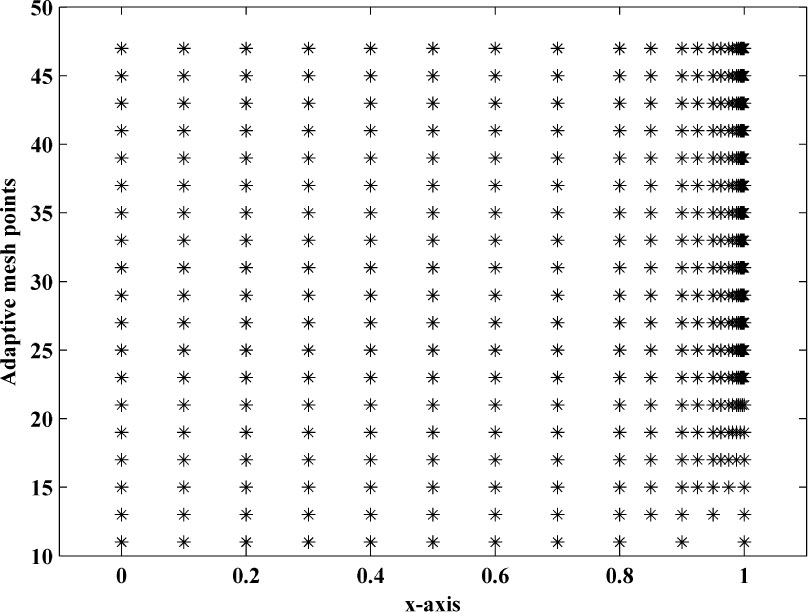
Adaptive mesh generation for example 5.2 with ε = 2−20, δ = 0, η = 0.5, M=10(initially) and N=20.
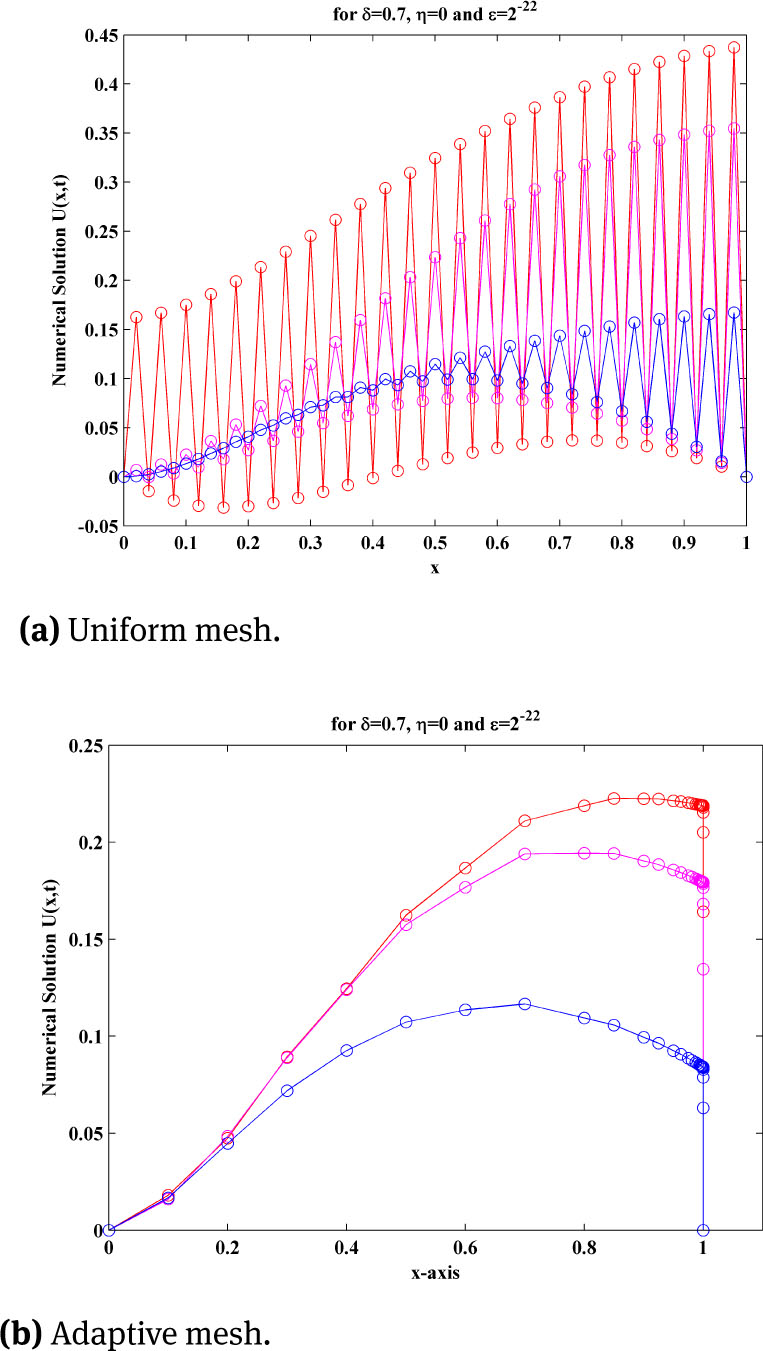
Numerical solution of example 5.2, using uniform mesh and adaptive mesh for three different time level with ε = 2−22, δ = 0.7, η = 0, M=50 and N=20.
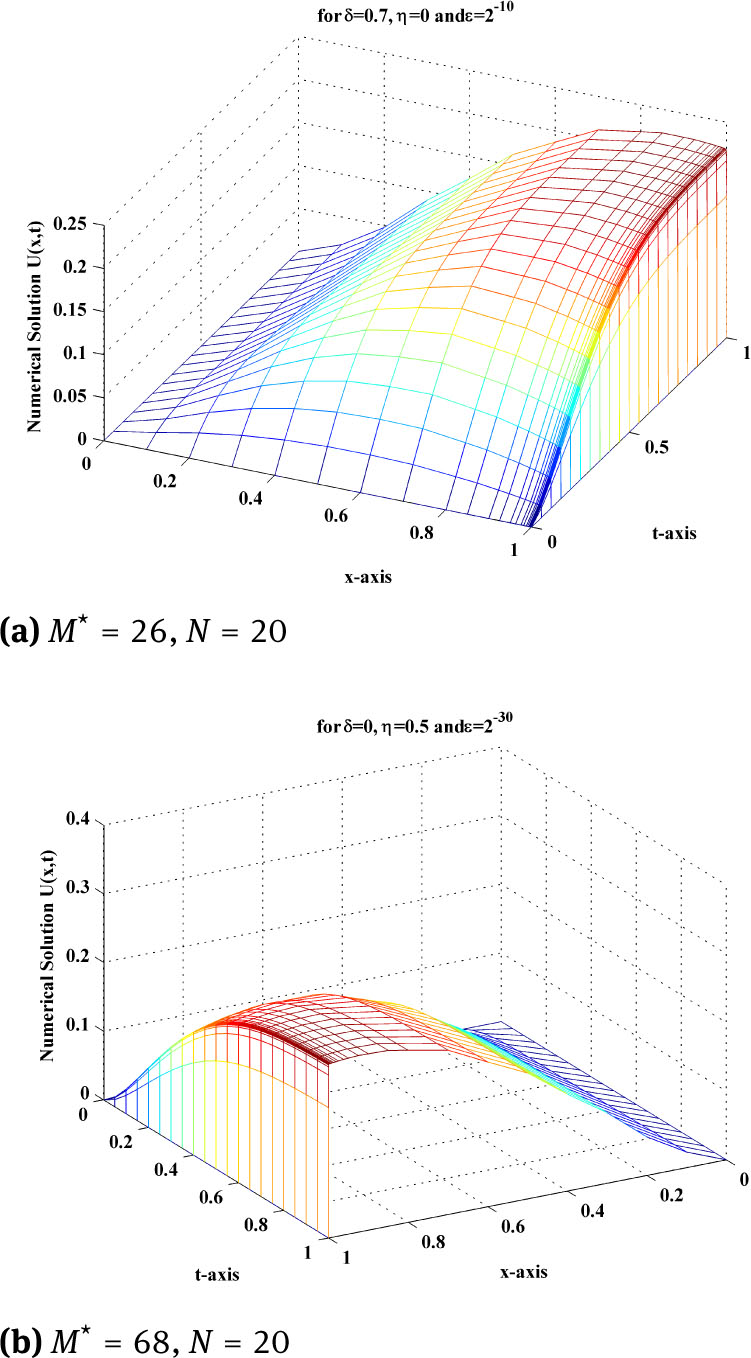
Surface plot of example 5.2, using adaptive mesh for different values of ϵ, δ and η.
Maximum point wise errors of the solution and corresponding rate of convergence for Example 5.2 by taking δ = 0.6, η = 0.7, M=10 and N=20 for different values of ε.
| ε | Generated mesh | Max. error | Rate of Convergenci |
|---|---|---|---|
| (M*) | (RM*,N) | ||
| 2–10 | 26 | 1.0006e-02 | 1.3435 |
| 2–15 | 36 | 1.0058e-02 | 1.3392 |
| 2–20 | 46 | 1.3391e-02 | 1.3391 |
| 2–25 | 58 | 1.0059e-02 | 1.3391 |
| 2-30 | 68 | 1.0059e-02 | 1.3391 |
Maximum point wise errors of the solution and corresponding rate of convergence for Example 5.2 by taking δ = 0, η = 0.5, M=10 and N=20 for different values of ε.
| ε | Generated mesh | Max. error | Rate of Convergence |
|---|---|---|---|
| (M*) | (RM*,N) | ||
| 2–10 | 26 | 1.1246e-02 | 1.3077 |
| 2–15 | 36 | 1.1300e-02 | 1.3033 |
| 2–20 | 46 | 1.1302e-02 | 1.3031 |
| 2–25 | 58 | 1.1302e-02 | 1.3031 |
| 2–30 | 68 | 1.1302e-02 | 1.3031 |
Maximum point wise errors of the solution and corresponding rate of convergence for Example 5.2 by taking δ = 0.7, η = 0, M=10 and N=20 for different values of ε.
| ε | Generated mesh | Max. error | Rate of Convergence |
|---|---|---|---|
| (M*) | (RM*,N) | ||
| 2−10 | 26 | 1.0145e-02 | 1.3435 |
| 2−15 | 36 | 1.0193e-02 | 1.3392 |
| 2−20 | 46 | 1.0194e-02 | 1.3391 |
| 2−25 | 58 | 1.0194e-02 | 1.3391 |
| 2−30 | 68 | 1.0194e-02 | 1.3391 |
Example 5.3
[3] Consider the following singularly perturbed partial differential equation:
where (x, t) ∈ (0, 1) × (0, 3] and is subject to the following interval boundary conditions and the initial condition,
The adaptive mesh generation with ε = 2−30, for this example is plotted in Figure 7. The numerical solution of the central finite difference scheme on uniform mesh and on adaptive mesh for three different time level with δ = 0.1 and η = 0.2, for this example, is plotted in Figure 8a and Figure 8b. To examine the effect of shift parameters on the boundary layer behaviour of the solution, surface plot of the solution of example 5.3 for different values of ε and δ and η, using adaptive mesh is plotted in Figure 9a and Figure 9b. The maximum point wise errors and rate of convergence are presented in Table 5 for this boundary value problem for different values of perturbation parameter ε.
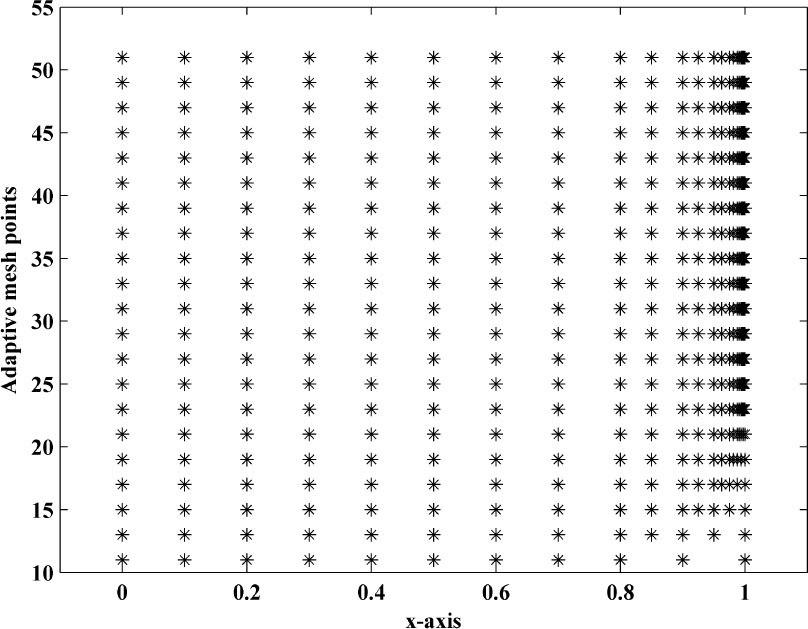
Adaptive mesh generation for example 5.3 with ε = 2−30, δ = 0.1, η = 0.2, M=10(initially) and N=20.
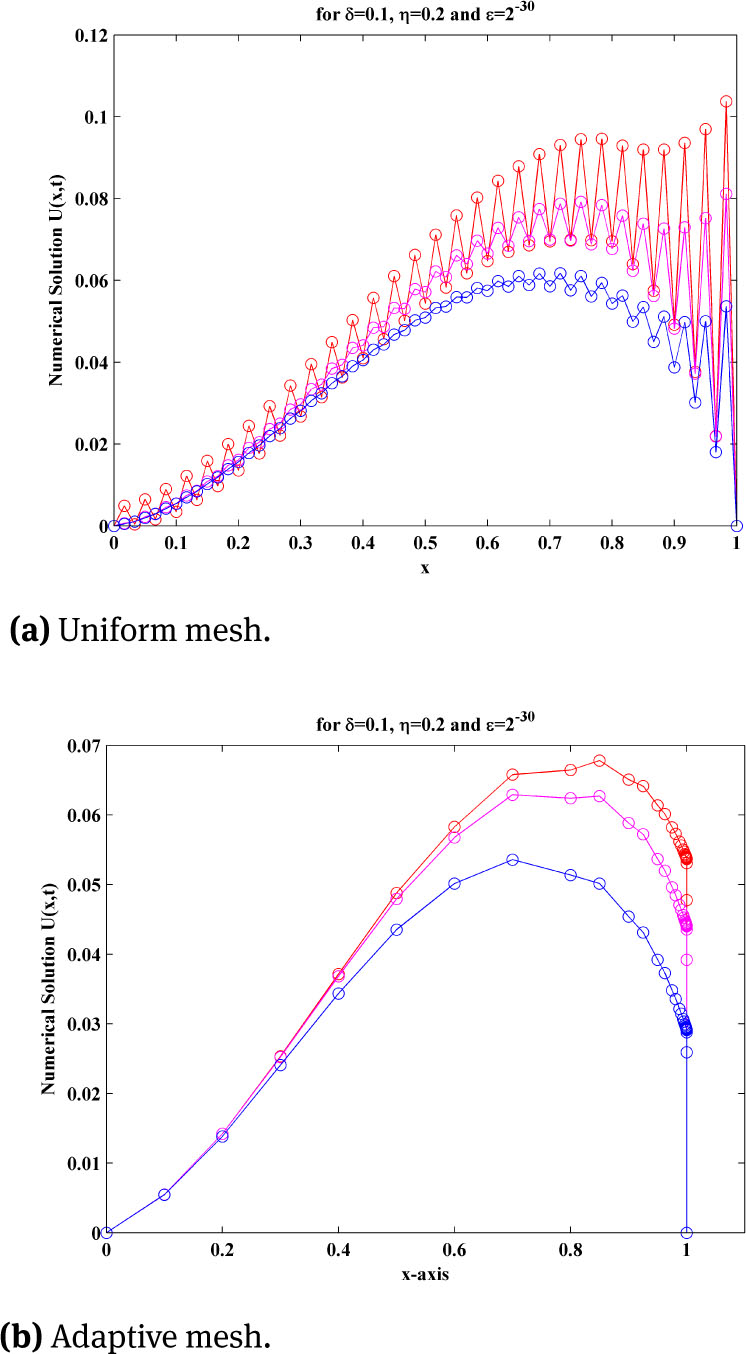
Numerical solution of example 5.3, using uniform mesh and adaptive mesh for three different time level with ε = 2−30, δ = 0.1, η = 0.2, M=60 and N=20.
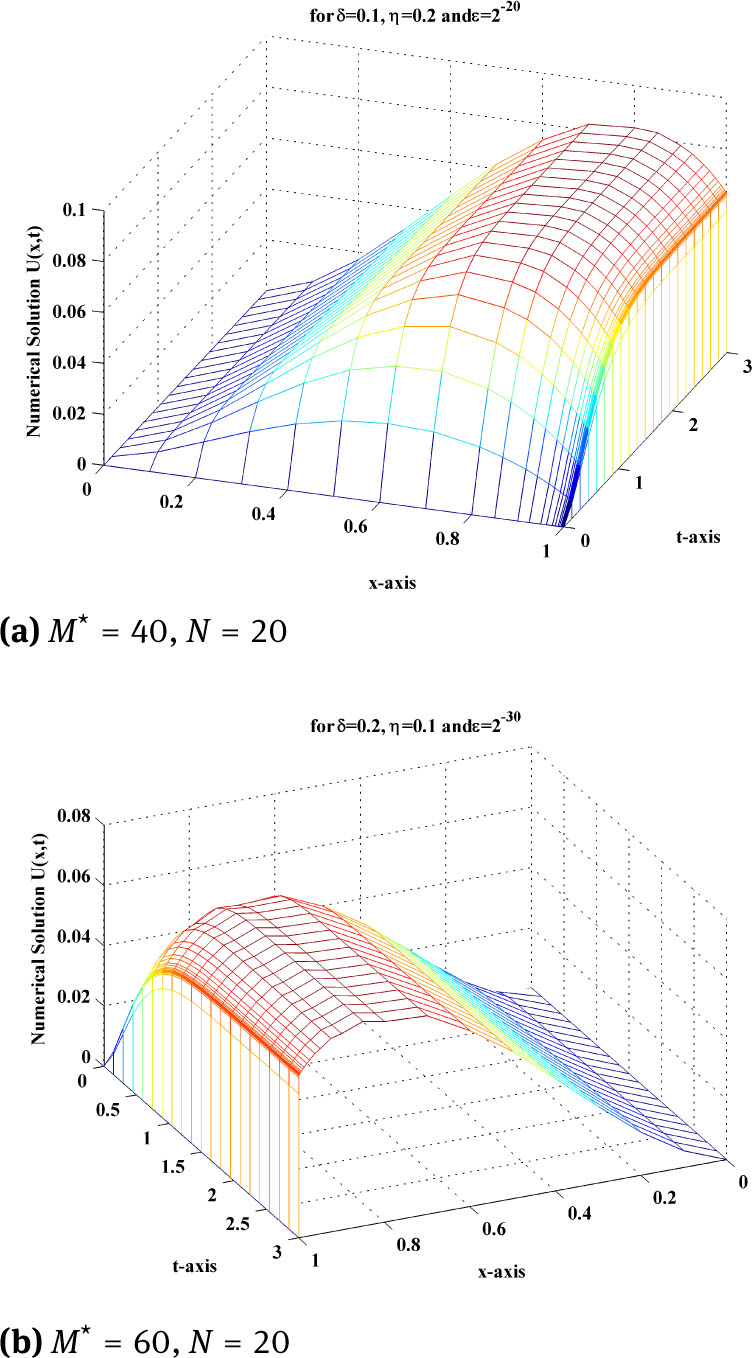
Surface plot of example 5.3, using adaptive mesh for different values of ϵ, δ and η.
Maximum point wise errors of the solution and corresponding rate of convergence for Example 5.3 by taking δ = 0.1, η = 0.2, M=10 and N=20 for different values of ε.
| ε | Generated mesh | Max. error | Rate of Convergence |
|---|---|---|---|
| (M*) | (RM*,N) | ||
| 2−10 | 20 | 4.0629e-03 | 0.7271 |
| 2−11 | 22 | 4.1600e-03 | 0.7421 |
| 2−12 | 24 | 4.2101e-03 | 0.7483 |
| 2−13 | 26 | 4.2353e-03 | 0.7514 |
| 2−14 | 28 | 4.2479e-03 | 0.7533 |
| 2−15 | 30 | 4.2542e-03 | 0.7544 |
| 2−16 | 32 | 4.2573e-03 | 0.7551 |
| 2−17 | 34 | 4.2589e-03 | 0.7555 |
| 2−18 | 36 | 4.2597e-03 | 0.7557 |
| 2−19 | 38 | 4.2600e-03 | 0.7558 |
| 2−20 | 40 | 4.2603e-03 | 0.7558 |
| 2−21 | 42 | 4.2604e-03 | 0.7559 |
| 2−22 | 44 | 4.2604e-03 | 0.7559 |
| 2−23 | 46 | 4.2604e-03 | 0.7559 |
| 2−24 | 48 | 4.2604e-03 | 0.7559 |
| 2−25 | 50 | 4.2604e-03 | 0.7559 |
| 2−26 | 52 | 4.2604e-03 | 0.7559 |
| 2−27 | 54 | 4.2604e-03 | 0.7559 |
| 2−28 | 56 | 4.2604e-03 | 0.7559 |
| 2−29 | 58 | 4.2604e-03 | 0.7559 |
| 2−30 | 60 | 4.2604e-03 | 0.7559 |
6 Conclusions
In this work, a time dependent singularly perturbed differential-difference convection-diffusion equation is solved numerically by using an adaptive grid method. To discretize the domain, we used uniform mesh in the temporal direction and an adaptive mesh has been generated using the concept of entropy function for the spatial direction. The method is based on central finite difference scheme. It has been found that our algorithm gives oscillation free solution with a minimum no of mesh points. Numerical results are carried out to show the efficiency and accuracy of the method. From the results it can be observed that, the method converges uniformly with respect to the perturbation parameter ε. It is also observed and shown in figures that how perturbation parameter ε and shift parameters δ and η effect the boundary layer behaviour of solutions. From the numerical results, it is concluded that our adaptive mesh offers a significant advantage with compare to Bakhvalov and Shishkin meshes. The computation is simple and intuitive.
References
[1] O. Arino, M.L. Hbid, E. Ait Dads, Delay differential equations and applications, Springer, Berlin, 2006.10.1007/1-4020-3647-7Search in Google Scholar
[2] N.S. Bakhvalov, On the optimization of the methods for solving boundary value problems in the presence of boundary layers, Zh. Vychisl. Mater. Fiz. 9(1969), pp. 841–859.Search in Google Scholar
[3] K. Bansal, K.K. Sharma, Parameter uniform numerical scheme for time dependent singularly perturbed convection-diffusion-reaction problems with general shift arguments, Numer. Algor. 75(1)(2017), pp. 113–145.10.1007/s11075-016-0199-3Search in Google Scholar
[4] K. Bansal, P. Rai, K.K. Sharma, Numerical treatment for the class of time dependent singularly perturbed parabolic problems with general shift arguments, Differ. Equ. Dyn. Syst. 25(2)(2017), pp. 327–346.10.1007/s12591-015-0265-7Search in Google Scholar
[5] O. Cheng, M. Jia-qi, The nonlinear singularly perturbed problems for predator-prey reaction diffusion equation, J. Biomath. 20(2)(2005), pp. 135–141.Search in Google Scholar
[6] E.R. Doolan, J.J.H. Miller, W.H.A. Schilders, Uniform numerical methods for problems with initial and boundary layers, Boole Press, Dublin, 1980.Search in Google Scholar
[7] A. Friedman, Partial differential equations of parabolic type, Prentice-hall, Englewood Cliffs, 1964.Search in Google Scholar
[8] E.C. Gartland, Graded-mesh difference schemes for singularly perturbed two-point boundary value problems, Math. Comput. 51(184)(1988), pp. 631–657.10.1090/S0025-5718-1988-0935072-1Search in Google Scholar
[9] D. Kumar, M.K. Kadalbajoo, A parameter-uniform numerical method for time dependent singularly perturbed differential-difference equations, Appl. Math. Model. 35(6)(2011), pp. 2805–2819.10.1016/j.apm.2010.11.074Search in Google Scholar
[10] V. Kumar, B. Srinivasan, An adaptive mesh strategy for singularly perturbed convection diffusion problems, Appl. Math. Model. 39(2015), pp. 2081–2091.10.1016/j.apm.2014.10.019Search in Google Scholar
[11] C.G. Lange, R.M. Miura, Singular perturbation analysis of boundary-value problems for differential-difference equations, SIAM J. Appl. Math. 42(1982), pp.502–531.10.1137/0142036Search in Google Scholar
[12] J.J.H. Miller, E.O. Riordan and I.G. Shishkin, Fitted numerical methods for singular perturbation problems, Word Scientific, Singapore, 1996.10.1142/2933Search in Google Scholar
[13] M. Musila, P. Lansky, Generalized Stein’s model for anatomically complex neurons, BioSystems. 25(3)(1991), pp. 179–191.10.1016/0303-2647(91)90004-5Search in Google Scholar
[14] J.D. Murray, Mathematical Biology I: An Introduction, third edition, Springer-Verlag, Berlin, 2001.Search in Google Scholar
[15] V.P. Ramesh, M.K. Kadalbajoo, Upwind and midpoint upwind difference method for time dependent singularly perturbed differential-difference equations with layer behavior, Appl. Math. Comput. 202(2)(2008), pp. 453–471.Search in Google Scholar
[16] R.N. Rao, P.P. Chakravarthy, Fitted numerical methods for singularly perturbed one-dimensional parabolic partial differential equations with small shifts arising in the modelling of neuronal variability, Differ. Equ. Dyn. Syst. (2017), pp. 1–18.Search in Google Scholar
[17] H.G. Roos, M. Stynes and L. Tobiska, Numerical Methods for Singularly Perturbed Differential Equations, Springer-Verlag, Berlin, 2008.Search in Google Scholar
[18] V.A. Solonnikov, O.A. Ladyzenskaja and N.N. Ural’ceva, Linear and quasi linear equations of parabolic type, American Mathematical Society Providence, Rhode Island, 1988.Search in Google Scholar
[19] R.B. Stein, A theoretical analysis of neuronal variability, Biophys.J. 5(2)(1965), pp. 173–194.10.1016/S0006-3495(65)86709-1Search in Google Scholar
[20] J. Wu, Theory and applications of partial functional differential equations, Springer, NewYork, 1996.10.1007/978-1-4612-4050-1Search in Google Scholar
© 2019 P.P. Chakravarthy and K. Kumar, published by De Gruyter
This work is licensed under the Creative Commons Attribution 4.0 Public License.
Articles in the same Issue
- Chebyshev Operational Matrix Method for Lane-Emden Problem
- Concentrating solar power tower technology: present status and outlook
- Control of separately excited DC motor with series multi-cells chopper using PI - Petri nets controller
- Effect of boundary roughness on nonlinear saturation of Rayleigh-Taylor instability in couple-stress fluid
- Effect of Heterogeneity on Imbibition Phenomena in Fluid Flow through Porous Media with Different Porous Materials
- Electro-osmotic flow of a third-grade fluid past a channel having stretching walls
- Heat transfer effect on MHD flow of a micropolar fluid through porous medium with uniform heat source and radiation
- Local convergence for an eighth order method for solving equations and systems of equations
- Numerical techniques for behavior of incompressible flow in steady two-dimensional motion due to a linearly stretching of porous sheet based on radial basis functions
- Influence of Non-linear Boussinesq Approximation on Natural Convective Flow of a Power-Law Fluid along an Inclined Plate under Convective Thermal Boundary Condition
- A reliable analytical approach for a fractional model of advection-dispersion equation
- Mass transfer around a slender drop in a nonlinear extensional flow
- Hydromagnetic Flow of Heat and Mass Transfer in a Nano Williamson Fluid Past a Vertical Plate With Thermal and Momentum Slip Effects: Numerical Study
- A Study on Convective-Radial Fins with Temperature-dependent Thermal Conductivity and Internal Heat Generation
- An effective technique for the conformable space-time fractional EW and modified EW equations
- Fractional variational iteration method for solving time-fractional Newell-Whitehead-Segel equation
- New exact and numerical solutions for the effect of suction or injection on flow of nanofluids past a stretching sheet
- Numerical investigation of MHD stagnation-point flow and heat transfer of sodium alginate non-Newtonian nanofluid
- A New Finance Chaotic System, its Electronic Circuit Realization, Passivity based Synchronization and an Application to Voice Encryption
- Analysis of Heat Transfer and Lifting Force in a Ferro-Nanofluid Based Porous Inclined Slider Bearing with Slip Conditions
- Application of QLM-Rational Legendre collocation method towards Eyring-Powell fluid model
- Hyperbolic rational solutions to a variety of conformable fractional Boussinesq-Like equations
- MHD nonaligned stagnation point flow of second grade fluid towards a porous rotating disk
- Nonlinear Dynamic Response of an Axially Functionally Graded (AFG) Beam Resting on Nonlinear Elastic Foundation Subjected to Moving Load
- Swirling flow of couple stress fluid due to a rotating disk
- MHD stagnation point slip flow due to a non-linearly moving surface with effect of non-uniform heat source
- Effect of aligned magnetic field on Casson fluid flow over a stretched surface of non-uniform thickness
- Nonhomogeneous porosity and thermal diffusivity effects on stability and instability of double-diffusive convection in a porous medium layer: Brinkman Model
- Magnetohydrodynamic(MHD) Boundary Layer Flow of Eyring-Powell Nanofluid Past Stretching Cylinder With Cattaneo-Christov Heat Flux Model
- On the connection coefficients and recurrence relations arising from expansions in series of modified generalized Laguerre polynomials: Applications on a semi-infinite domain
- An adaptive mesh method for time dependent singularly perturbed differential-difference equations
- On stretched magnetic flow of Carreau nanofluid with slip effects and nonlinear thermal radiation
- Rational exponential solutions of conformable space-time fractional equal-width equations
- Simultaneous impacts of Joule heating and variable heat source/sink on MHD 3D flow of Carreau-nanoliquids with temperature dependent viscosity
- Effect of magnetic field on imbibition phenomenon in fluid flow through fractured porous media with different porous material
- Impact of ohmic heating on MHD mixed convection flow of Casson fluid by considering Cross diffusion effect
- Mathematical Modelling Comparison of a Reciprocating, a Szorenyi Rotary, and a Wankel Rotary Engine
- Surface roughness effect on thermohydrodynamic analysis of journal bearings lubricated with couple stress fluids
- Convective conditions and dissipation on Tangent Hyperbolic fluid over a chemically heating exponentially porous sheet
- Unsteady Carreau-Casson fluids over a radiated shrinking sheet in a suspension of dust and graphene nanoparticles with non-Fourier heat flux
- An efficient numerical algorithm for solving system of Lane–Emden type equations arising in engineering
- New numerical method based on Generalized Bessel function to solve nonlinear Abel fractional differential equation of the first kind
- Numerical Study of Viscoelastic Micropolar Heat Transfer from a Vertical Cone for Thermal Polymer Coating
- Analysis of Bifurcation and Chaos of the Size-dependent Micro–plate Considering Damage
- Non-Similar Comutational Solutions for Double-Diffusive MHD Transport Phenomena for Non-Newtnian Nanofluid From a Horizontal Circular Cylinder
- Mathematical model on distributed denial of service attack through Internet of things in a network
- Postbuckling behavior of functionally graded CNT-reinforced nanocomposite plate with interphase effect
- Study of Weakly nonlinear Mass transport in Newtonian Fluid with Applied Magnetic Field under Concentration/Gravity modulation
- MHD slip flow of chemically reacting UCM fluid through a dilating channel with heat source/sink
- A Study on Non-Newtonian Transport Phenomena in Mhd Fluid Flow From a Vertical Cone With Navier Slip and Convective Heating
- Penetrative convection in a fluid saturated Darcy-Brinkman porous media with LTNE via internal heat source
- Traveling wave solutions for (3+1) dimensional conformable fractional Zakharov-Kuznetsov equation with power law nonlinearity
- Semitrailer Steering Control for Improved Articulated Vehicle Manoeuvrability and Stability
- Thermomechanical nonlinear stability of pressure-loaded CNT-reinforced composite doubly curved panels resting on elastic foundations
- Combination synchronization of fractional order n-chaotic systems using active backstepping design
- Vision-Based CubeSat Closed-Loop Formation Control in Close Proximities
- Effect of endoscope on the peristaltic transport of a couple stress fluid with heat transfer: Application to biomedicine
- Unsteady MHD Non-Newtonian Heat Transfer Nanofluids with Entropy Generation Analysis
- Mathematical Modelling of Hydromagnetic Casson non-Newtonian Nanofluid Convection Slip Flow from an Isothermal Sphere
- Influence of Joule Heating and Non-Linear Radiation on MHD 3D Dissipating Flow of Casson Nanofluid past a Non-Linear Stretching Sheet
- Radiative Flow of Third Grade Non-Newtonian Fluid From A Horizontal Circular Cylinder
- Application of Bessel functions and Jacobian free Newton method to solve time-fractional Burger equation
- A reliable algorithm for time-fractional Navier-Stokes equations via Laplace transform
- A multiple-step adaptive pseudospectral method for solving multi-order fractional differential equations
- A reliable numerical algorithm for a fractional model of Fitzhugh-Nagumo equation arising in the transmission of nerve impulses
- The expa function method and the conformable time-fractional KdV equations
- Comment on the paper: “Thermal radiation and chemical reaction effects on boundary layer slip flow and melting heat transfer of nanofluid induced by a nonlinear stretching sheet, M.R. Krishnamurthy, B.J. Gireesha, B.C. Prasannakumara, and Rama Subba Reddy Gorla, Nonlinear Engineering 2016, 5(3), 147-159”
- Three-Dimensional Boundary layer Flow and Heat Transfer of a Fluid Particle Suspension over a Stretching Sheet Embedded in a Porous Medium
- MHD three dimensional flow of Oldroyd-B nanofluid over a bidirectional stretching sheet: DTM-Padé Solution
- MHD Convection Fluid and Heat Transfer in an Inclined Micro-Porous-Channel
Articles in the same Issue
- Chebyshev Operational Matrix Method for Lane-Emden Problem
- Concentrating solar power tower technology: present status and outlook
- Control of separately excited DC motor with series multi-cells chopper using PI - Petri nets controller
- Effect of boundary roughness on nonlinear saturation of Rayleigh-Taylor instability in couple-stress fluid
- Effect of Heterogeneity on Imbibition Phenomena in Fluid Flow through Porous Media with Different Porous Materials
- Electro-osmotic flow of a third-grade fluid past a channel having stretching walls
- Heat transfer effect on MHD flow of a micropolar fluid through porous medium with uniform heat source and radiation
- Local convergence for an eighth order method for solving equations and systems of equations
- Numerical techniques for behavior of incompressible flow in steady two-dimensional motion due to a linearly stretching of porous sheet based on radial basis functions
- Influence of Non-linear Boussinesq Approximation on Natural Convective Flow of a Power-Law Fluid along an Inclined Plate under Convective Thermal Boundary Condition
- A reliable analytical approach for a fractional model of advection-dispersion equation
- Mass transfer around a slender drop in a nonlinear extensional flow
- Hydromagnetic Flow of Heat and Mass Transfer in a Nano Williamson Fluid Past a Vertical Plate With Thermal and Momentum Slip Effects: Numerical Study
- A Study on Convective-Radial Fins with Temperature-dependent Thermal Conductivity and Internal Heat Generation
- An effective technique for the conformable space-time fractional EW and modified EW equations
- Fractional variational iteration method for solving time-fractional Newell-Whitehead-Segel equation
- New exact and numerical solutions for the effect of suction or injection on flow of nanofluids past a stretching sheet
- Numerical investigation of MHD stagnation-point flow and heat transfer of sodium alginate non-Newtonian nanofluid
- A New Finance Chaotic System, its Electronic Circuit Realization, Passivity based Synchronization and an Application to Voice Encryption
- Analysis of Heat Transfer and Lifting Force in a Ferro-Nanofluid Based Porous Inclined Slider Bearing with Slip Conditions
- Application of QLM-Rational Legendre collocation method towards Eyring-Powell fluid model
- Hyperbolic rational solutions to a variety of conformable fractional Boussinesq-Like equations
- MHD nonaligned stagnation point flow of second grade fluid towards a porous rotating disk
- Nonlinear Dynamic Response of an Axially Functionally Graded (AFG) Beam Resting on Nonlinear Elastic Foundation Subjected to Moving Load
- Swirling flow of couple stress fluid due to a rotating disk
- MHD stagnation point slip flow due to a non-linearly moving surface with effect of non-uniform heat source
- Effect of aligned magnetic field on Casson fluid flow over a stretched surface of non-uniform thickness
- Nonhomogeneous porosity and thermal diffusivity effects on stability and instability of double-diffusive convection in a porous medium layer: Brinkman Model
- Magnetohydrodynamic(MHD) Boundary Layer Flow of Eyring-Powell Nanofluid Past Stretching Cylinder With Cattaneo-Christov Heat Flux Model
- On the connection coefficients and recurrence relations arising from expansions in series of modified generalized Laguerre polynomials: Applications on a semi-infinite domain
- An adaptive mesh method for time dependent singularly perturbed differential-difference equations
- On stretched magnetic flow of Carreau nanofluid with slip effects and nonlinear thermal radiation
- Rational exponential solutions of conformable space-time fractional equal-width equations
- Simultaneous impacts of Joule heating and variable heat source/sink on MHD 3D flow of Carreau-nanoliquids with temperature dependent viscosity
- Effect of magnetic field on imbibition phenomenon in fluid flow through fractured porous media with different porous material
- Impact of ohmic heating on MHD mixed convection flow of Casson fluid by considering Cross diffusion effect
- Mathematical Modelling Comparison of a Reciprocating, a Szorenyi Rotary, and a Wankel Rotary Engine
- Surface roughness effect on thermohydrodynamic analysis of journal bearings lubricated with couple stress fluids
- Convective conditions and dissipation on Tangent Hyperbolic fluid over a chemically heating exponentially porous sheet
- Unsteady Carreau-Casson fluids over a radiated shrinking sheet in a suspension of dust and graphene nanoparticles with non-Fourier heat flux
- An efficient numerical algorithm for solving system of Lane–Emden type equations arising in engineering
- New numerical method based on Generalized Bessel function to solve nonlinear Abel fractional differential equation of the first kind
- Numerical Study of Viscoelastic Micropolar Heat Transfer from a Vertical Cone for Thermal Polymer Coating
- Analysis of Bifurcation and Chaos of the Size-dependent Micro–plate Considering Damage
- Non-Similar Comutational Solutions for Double-Diffusive MHD Transport Phenomena for Non-Newtnian Nanofluid From a Horizontal Circular Cylinder
- Mathematical model on distributed denial of service attack through Internet of things in a network
- Postbuckling behavior of functionally graded CNT-reinforced nanocomposite plate with interphase effect
- Study of Weakly nonlinear Mass transport in Newtonian Fluid with Applied Magnetic Field under Concentration/Gravity modulation
- MHD slip flow of chemically reacting UCM fluid through a dilating channel with heat source/sink
- A Study on Non-Newtonian Transport Phenomena in Mhd Fluid Flow From a Vertical Cone With Navier Slip and Convective Heating
- Penetrative convection in a fluid saturated Darcy-Brinkman porous media with LTNE via internal heat source
- Traveling wave solutions for (3+1) dimensional conformable fractional Zakharov-Kuznetsov equation with power law nonlinearity
- Semitrailer Steering Control for Improved Articulated Vehicle Manoeuvrability and Stability
- Thermomechanical nonlinear stability of pressure-loaded CNT-reinforced composite doubly curved panels resting on elastic foundations
- Combination synchronization of fractional order n-chaotic systems using active backstepping design
- Vision-Based CubeSat Closed-Loop Formation Control in Close Proximities
- Effect of endoscope on the peristaltic transport of a couple stress fluid with heat transfer: Application to biomedicine
- Unsteady MHD Non-Newtonian Heat Transfer Nanofluids with Entropy Generation Analysis
- Mathematical Modelling of Hydromagnetic Casson non-Newtonian Nanofluid Convection Slip Flow from an Isothermal Sphere
- Influence of Joule Heating and Non-Linear Radiation on MHD 3D Dissipating Flow of Casson Nanofluid past a Non-Linear Stretching Sheet
- Radiative Flow of Third Grade Non-Newtonian Fluid From A Horizontal Circular Cylinder
- Application of Bessel functions and Jacobian free Newton method to solve time-fractional Burger equation
- A reliable algorithm for time-fractional Navier-Stokes equations via Laplace transform
- A multiple-step adaptive pseudospectral method for solving multi-order fractional differential equations
- A reliable numerical algorithm for a fractional model of Fitzhugh-Nagumo equation arising in the transmission of nerve impulses
- The expa function method and the conformable time-fractional KdV equations
- Comment on the paper: “Thermal radiation and chemical reaction effects on boundary layer slip flow and melting heat transfer of nanofluid induced by a nonlinear stretching sheet, M.R. Krishnamurthy, B.J. Gireesha, B.C. Prasannakumara, and Rama Subba Reddy Gorla, Nonlinear Engineering 2016, 5(3), 147-159”
- Three-Dimensional Boundary layer Flow and Heat Transfer of a Fluid Particle Suspension over a Stretching Sheet Embedded in a Porous Medium
- MHD three dimensional flow of Oldroyd-B nanofluid over a bidirectional stretching sheet: DTM-Padé Solution
- MHD Convection Fluid and Heat Transfer in an Inclined Micro-Porous-Channel

